Marvel Heroes Full Review (Almost)
This is a review of the newly released MMO, Marvel Heroes
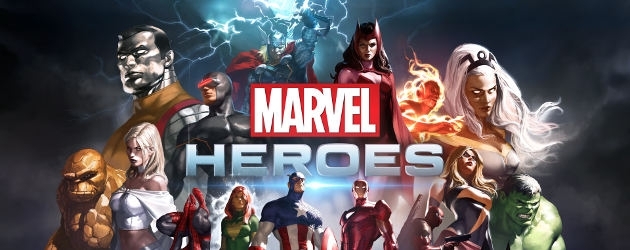
Comic book and Diablo fans rejoice, Marvel Heroes from Gazillion Entertainment is officially live! This game has a lot of familiar features, with the added twist of the Marvel Universe, and a fresh take on the Diablo-esque RPG style. Marvel Heroes feels surprisingly triple A, which is a relief in a market of disappointing free to play games. While I intend to focus more on the game itself in this piece, rather than its free to play features, I will note that this game is in no way pay to win. If you would like to know more about the Free to Play aspects of Marvel Heroes, Robert "Caergan" Gray of ZAM has a new Free Agent out about them! This game is, however, marketed as an MMO. While the term is starting to lose any specific definition, this game definitely rides the line of what constitutes an MMO. Essentially, it feels very much like a Diablo game, but replaces lobbies with an open world that includes event battles and auto grouping for instanced quests.
For the Marvel junkies out there, this game is an absolute must play. I myself am a fan of the Marvel universe, but by no means consider myself an expert in the matter. That being said, this game does an incredible job of both introducing new-comers to the story and getting them invested in said story and, at the same time, offering plenty of detailed tidbits for even the most hardcore of fans. If you’ve seen the movies, you will recognize a plethora familiar faces, and if you’ve read the comics, either casually or religiously, you will be introduced to many heroes and characters from the far reaches of the Marvel Universe that you have come to know and love.
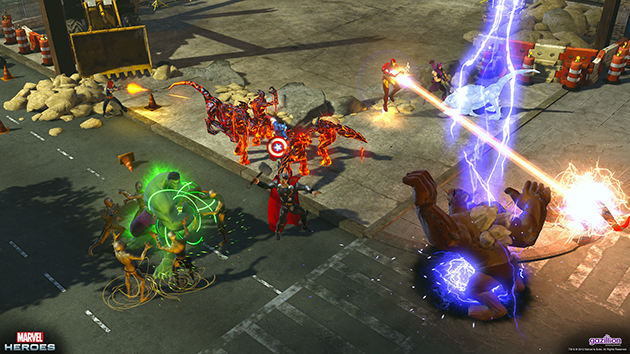
Now that we have the basics covered, let’s move on to some of the details. Right away, the player is thrust into an engaging story line, with interesting combat mechanics that are familiar to Diablo fans, but feel fresh and reawakened. David Brevik does an amazing job of including his Diablo influence, with the added twist of an open world and MMO style features. Once the player has completed the intro sequence, which is quite fun, he/she is then placed back into Avengers Tower, where he is offered the chance to continue the story, check out the crafting system, explore the tower, and access his stash, vendors and more. There are three major quest hubs in the game, Avengers Tower is the first, followed by Xavier’s School for Gifted Youngsters and finished off with the S.H.I.E.L.D. Helicarrier.
I didn’t actually get past the Avengers Tower. This game has a lot of content, even in the first hub. For Diablo players, it is fair to compare each of the three hubs to an Act; however, it is arguable that each hub has more hours’ worth of play than an Act might in Diablo. Traveling through waypoints is another familiar feature, and works the same way.
It is up to the players whether they choose to follow the clear quest path, or pick up side quests, explore the open world and defeat event bosses. Event bosses are one of the very entertaining pieces of content that differs from what we are used to in non-MMO RPGs. These bosses spawn over time, and require many players to defeat. Generally, the player will find him or herself in an open world zone, and will notice a tracker telling him that an event boss is near. Once the boss is approached, players will find themselves accompanied by 15 to 40 other players, all combating a powerful enemy. Bosses in this game are all super villains from the Marvel Universe. In some cases, they are in instanced quest areas that scale based on the number of players in your party. In other cases, they take the form of these major event bosses. Regardless of how they’re scaled, all bosses will be familiar enemies from the Marvel Universe.
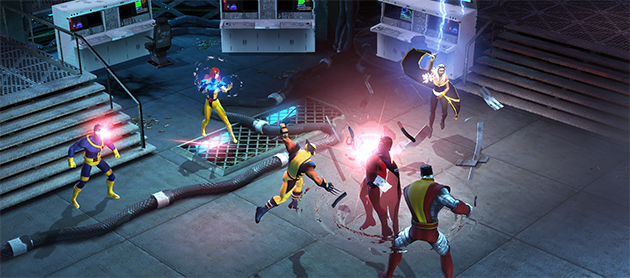
This game feels very streamlined in how you get around the world. When a primary story quest is completed, the player is offered a portal back to his current quest hub, but also has the option to backtrack into the open world. Waypoints will take you into a specific open world zone. This is where you play alongside anyone else in that zone, don’t require parties to work together to take down event bosses, work on open world quests and explore the zone. Within each open world zone, players will find entrances to small rooms, containing mini bosses, a loot chest and some quick experience. Also found are entrances to major parts of the story quests, where the player will be automatically grouped with other players (or, if you’re playing with friends, you can manually group beforehand), and these rooms generally contain a Story boss, with a lot of hack and slash content between entering and fighting the boss.
The process of getting to a new open world zone, exploring it, killing an event boss, exploring rooms, completing side quests, then defeating the story quest boss and traveling back to the hub is seamless. There was no point in my playtime that I experienced backtracking, or monotonous repetition of content. Assuming the player plays through the content right in front of him, the whole experience wraps itself up in a neat little bow.
Gearing up in Marvel Heroes is fun, but nothing particularly new. However, the game does offer an interesting addition to the common process. Each time a player defeats a boss, he is rewarded with a Medal. Each Medal is attributed to that specific boss, and will give the player bonuses that represent the boss that is paired with it. For example, the Rhino Medal grants the player a chance to knockback on attack. Other bonuses include increased Area of Effect damage, Increased life regeneration, chance to apply a debuff, chance to fire a special attack and the list goes on. This allows players to give themselves special advantages at a moment’s notice, assuming they have the Medals they need in their inventory. They add a fun aspect to an otherwise normal gearing system, and allow the player to make specific additions to his or her loadout based on preferred play style. Most of the bonuses are percentage based, and will scale alongside the player’s level, so there usually isn’t a need to constantly replace the Medal of choice every time a level is gained.
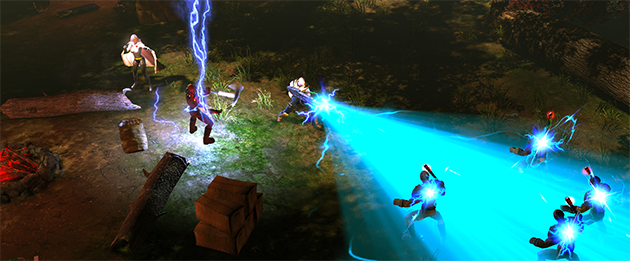
This game feels very streamlined in how you get around the world. When a primary story quest is completed, the player is offered a portal back to his current quest hub, but also has the option to backtrack into the open world. Waypoints will take you into a specific open world zone. This is where you play alongside anyone else in that zone, don’t require parties to work together to take down event bosses, work on open world quests and explore the zone. Within each open world zone, players will find entrances to small rooms, containing mini bosses, a loot chest and some quick experience. Also found are entrances to major parts of the story quests, where the player will be automatically grouped with other players (or, if you’re playing with friends, you can manually group beforehand), and these rooms generally contain a Story boss, with a lot of hack and slash content between entering and fighting the boss.
The process of getting to a new open world zone, exploring it, killing an event boss, exploring rooms, completing side quests, then defeating the story quest boss and traveling back to the hub is seamless. There was no point in my playtime that I experienced backtracking, or monotonous repetition of content. Assuming the player plays through the content right in front of him, the whole experience wraps itself up in a neat little bow.
Gearing up in Marvel Heroes is fun, but nothing particularly new. However, the game does offer an interesting addition to the common process. Each time a player defeats a boss, he is rewarded with a Medal. Each Medal is attributed to that specific boss, and will give the player bonuses that represent the boss that is paired with it. For example, the Rhino Medal grants the player a chance to knockback on attack. Other bonuses include increased Area of Effect damage, Increased life regeneration, chance to apply a debuff, chance to fire a special attack and the list goes on. This allows players to give themselves special advantages at a moment’s notice, assuming they have the Medals they need in their inventory. They add a fun aspect to an otherwise normal gearing system, and allow the player to make specific additions to his or her loadout based on preferred play style. Most of the bonuses are percentage based, and will scale alongside the player’s level, so there usually isn’t a need to constantly replace the Medal of choice every time a level is gained.
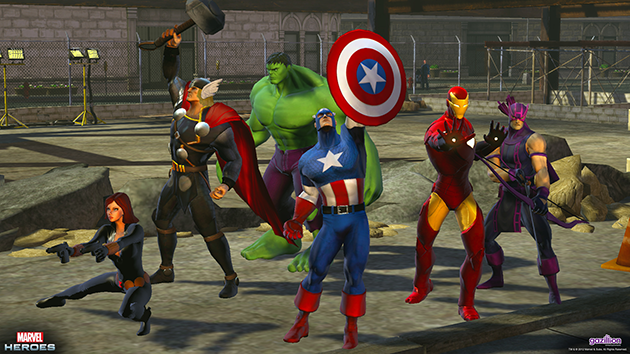
The gear that drops is hero specific, the same way gear in Diablo is class specific. However, with so many heroes to choose from, it comes as no surprise that there is a much higher chance for gear to drop that is specific to the hero being played at the time of drop. While I don’t have specific numbers on those drop rates, in my personal experience there was roughly an 80% chance for gear to drop that is specific to the hero being played, and 20% to get gear for other heroes. Again, those are estimates based on my personal experience, and your experience may differ.
Aside from gear, there are a few other things a player might see popping out of the carcass of a recently defeated enemy. Hero Tokens are the free way to acquire new heroes to play. The chance to drop is relatively low; however, they are the saving grace to keep non-paying players happy with new heroes to try out. If a Hero Token drops for a hero the player does not currently own, then all it takes is using the token to add that hero to the player’s roster. If the player already owns the hero, he can apply that token toward leveling up that hero’s Ultimate Power, but I’ll come back to that shortly.
The final item-set a player might see jumping out of his victims, is crafting supplies. Crafting in Marvel Heroes is relatively straightforward, and will seem rather easy to any veteran MMO player, however, the results of crafting are much more exciting. Players can craft special effects for their hero’s costumes, new pieces of specialized gear and powerful potions and consumables to allow players to push themselves to the highest levels of power.
On to the talent system; players will find themselves presented with a standard, well known system. While nothing about how the talent system works is anything new, the talents themselves are relatively fun and interesting. Each tree seems to be generalized to Offensive, Defensive and Utility, which will come as no surprise to any MMO player, however, those aspects are not defined, and there are instances where trees will intersect or overlap, outside of their pre-defined area of expertise. At level 30, players are granted their Ultimate Ability. At each level, the player is granted two talent points to spend in his or her tree, yet, the Ultimate Powers cannot be slotted with these points. Once level 30, the ability is unlocked, but the only way to upgrade it are the Hero Tokens I referred to earlier. Because of this, players always have a reason to get excited about a Hero Token dropping, no matter how long they’ve been playing the game.
Between Medals, Hero Tokens, and the ability to play multiple heroes on a whim, this game has plenty to keep players interested in furthering their experience in the world. For any hardcore Diablo fan, particularly those who were disappointed with Diablo 3, this game is a refreshing take on the RPG style, and has a level of polish that many free to play games lack. Plus, it’s free, so there’s really no reason not to pick it up and check it out. While that is all I have to say for now, I did not make it to the end game of Marvel Heroes just yet. The endgame includes things such as dungeons, challenges and PvP. Keep an eye out here on ZAM for another article on the endgame and, until then, go check out Marvel Heroes!
-Tyler "TovarishGaming" Solley